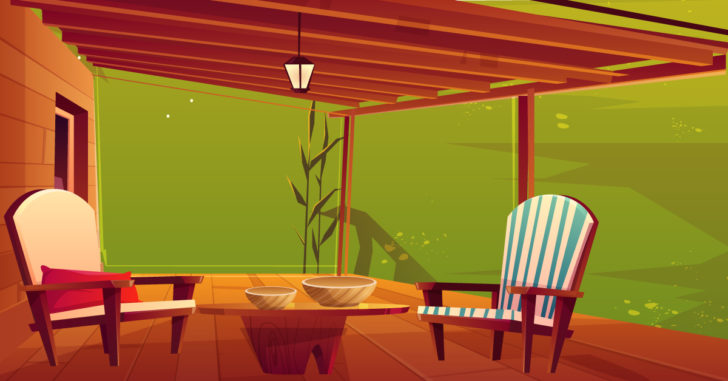Home
What Is Acacia Wood? Guide for Acacia Wood Properties, Advantages, Disadvantages, And Uses
Table of Contents
About Acacia and Acacia Wood:
Acacia, commonly known as the wattles or acacias, is a large genus of shrubs and trees in the subfamily Mimosoideae of the pea family Fabaceae. Initially, it comprised a group of plant species native to Africa and Australasia, but it has now been limited to contain only the Australasian species. The genus name is New Latin, borrowed from the Greek ἀκακία (akakia), a term used by Dioscorides for a preparation extracted from the leaves and fruit pods of Vachellia nilotica, the original type of the genus. In his Pinax (1623), Gaspard Bauhin mentioned the Greek ἀκακία from Dioscorides as the origin of the Latin name.
In the early 2000s it had become evident that the genus as it stood was not monophyletic and that several divergent lineages needed to be placed in separate genera. It turned out that one lineage comprising over 900 species mainly native to Australia, New Guinea, and Indonesia was not closely related to the much smaller group of African lineage that contained A. nilotica—the type species.
This meant that the Australasian lineage (by far the most prolific in number of species) would need to be renamed. Botanist Leslie Pedley named this group Racosperma, which received little acclaim in the botanical community. Australian botanists proposed a less disruptive solution setting a different type species for Acacia (A. penninervis) and allowing this largest number of species to remain in Acacia, resulting in the two Pan-Tropical lineages being renamed Vachellia and Senegalia, and the two endemic American lineages renamed Acaciella and Mariosousa. Although many botanists still disagreed that this was necessary, this solution was eventually officially adopted at the Melbourne International Botanical Congress in 2011.
Acacia remains a widely used common name across genera.
A number of species have been introduced to various parts of the world, and two million hectares of commercial plantations have been established. The heterogeneous group varies considerably in habit, from mat-like subshrubs to canopy trees in a forest.
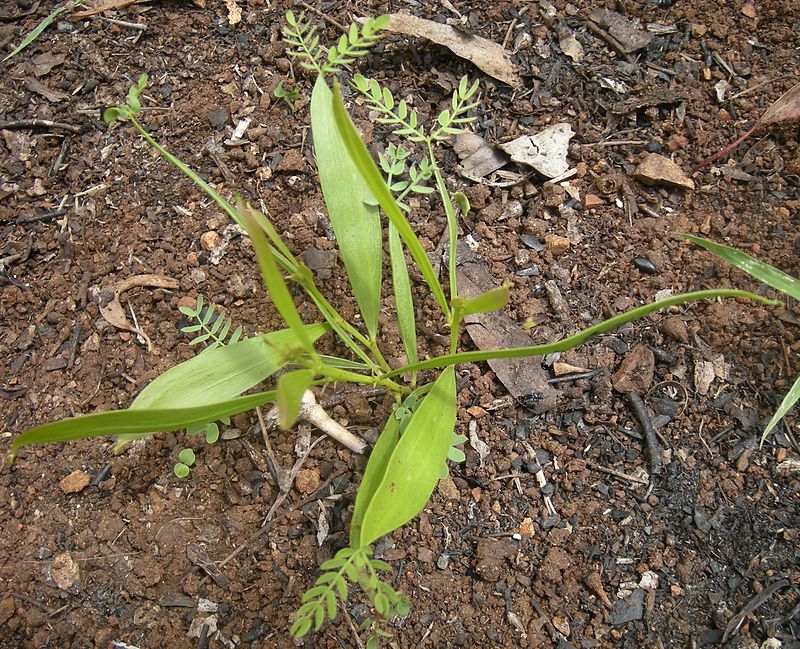
According to a BBC report, there are 60,000 tree species in the world.
Each has a different texture, color, density, shrinkage and shine.
But today we would be discussing the Acacia tree.
And why should you consider this extraordinary type of wood for your needs?
Let’s roll!
What Is Acacia Wood
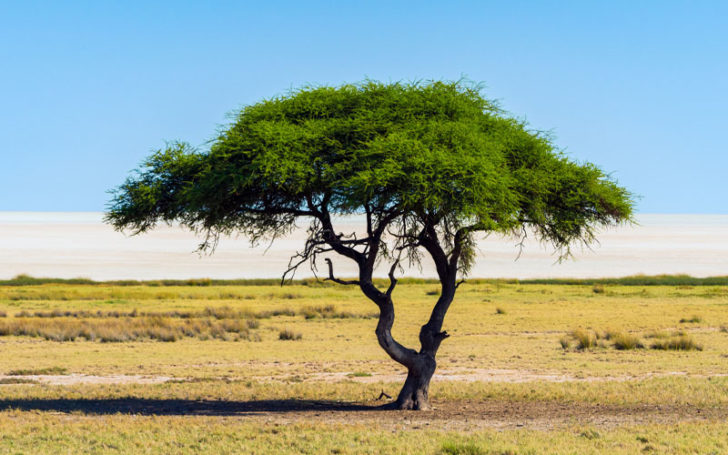
Acacia is a hardwood derived from acacia trees and shrubs native to Australia but also found in Asia, the Pacific Islands, Africa, and some other parts of the Americas.
Acacia wood is found in hundreds of hardwoods, and all varieties are used in the manufacture of furniture, household items, kitchenware, flooring and other wood accessories.
Do you know: Acacia trees can grow tall up to 20 – 100 feet in length and have a flattened crown.
Acacia Wood species include Babul, Hawaiian Koa, Acacia Mangium, and Acacia Melanoxylon.
Acacia Wood Properties
Advantageous features of acacia wood include its dark brown color ranging from amber to wine-colored, and its natural fine grain structure that is not easily scratched. It is water resistant, immune to fungi and has straight or curved patterns.
All these features make it the best choice for home and household items.
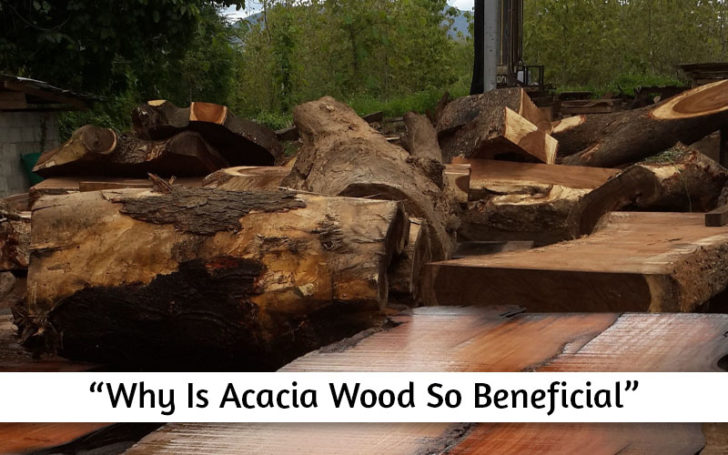
Physical appereance:
Acacia wood has a deep hue of reddish brown, although there is a full spectrum of colors from light brown to deep red.
Grainy Texture:
Besides golden grains, there are also dull, brown ones. Two boards of this wood would rarely be the same.
Acacia Wood Hardness:
According to Carpet Express (JANKA Acacia Hardness Number 2200), it is 70% harder than Red Oak and 65% harder than White Oak.
Acacia Wood Endurance VS Oak:
Its density is 800 kg/m3 and it is 14% more than Red Oak and 4% more than White Oak.
Acacia Wood Strength:
It is a heavy wood, usually heavier than any other normal construction wood such as Oak, Spruce, Pine.
resistant:
Acacia wood is highly resistant to cracking thanks to its flexibility. Furniture made of acacia wood means it won’t break easily.
Extremely prone to scratches:
The surface of acacia wood is very shiny and slippery, which makes it very strong against scratches. Since the natural surface of acacia is scratch-free, it does not require more frequent painting.
Acacia Wood Durability:
It is one of the most durable woods in the world due to its hardness, weight, water resistance and scratch resistance.
It was historically used to build ships and boats, and today it is widely used for furniture, flooring, cutting boards and bowls.
Acacia Tree Sustainability:
It is an extremely sustainable tree species. First, because it requires less time to grow. They have a short lifespan of 15-30 years, while oak trees have an average lifespan of 80-200 years.
Secondly, they are consumed only after the extract has been used, which means that it is no longer useful for birds, animals and insects.
“Acacia Grain structure varies between straight to irregular (but normally wavy); no two Acacia planks are equal.”
When considering the purchase of Acacia Wood products, you should consider not only its features, but also the advantages and disadvantages of Acacia wood.
Why?
Thus, you can configure whether your sweet home and daily routine are ready to accept this particular type of wood.
Check out:
Acacia Wood Uses
You wouldn’t be looking for it if you weren’t interested in finding its best uses.
True?
1. Acacia Wood Furniture
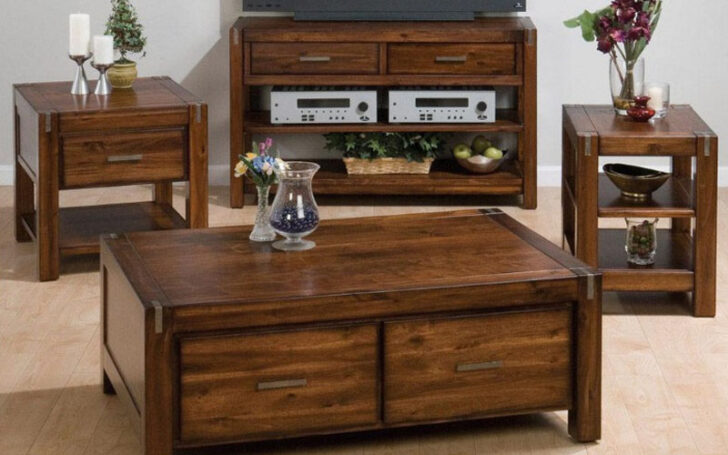
Of course all other woods are used for furniture, but what makes this type so superior?
Good:
It is due to its durability, hardness, scratch resistance, sustainability and machinability properties.
Take care to dig a little deeper:
Firstly:
Babul and Australian Blackwood are the best types of Acacia wood used for furniture, with a Janka Hardness rating of 2300 and 1160 respectively, with a lifespan of around 40 years.
Acacia has proven its quality of being extremely durable. Its hardness and density make it one of the most popular choices for furniture lately.
Dining tables, chairs, beds are made from it and they resist time.
Second:
It is very prone to scratches due to its interlocking grain structure. Insects and fungi cannot enter this wood.
So you can easily make dining tables, entertainment centers and desks.
Third:
Because acacia trees are so abundant in the universe, furniture consumption is considered sustainable.
Many farmers only cut down trees after the sap has been used up or if it is completely useless (and can only be effectively used for furniture).
Fourth:
While difficult to cut, it can be easily planed and varnished, increasing its ease of molding into furniture pieces such as chairs, tables, and drawers.
Babul can be easily processed prior to drying to create smooth and desirable live-edge pieces.
The fact that the boards are long also makes it much easier to manufacture long items such as dining tables and benches.
2. Acacia Wood Flooring
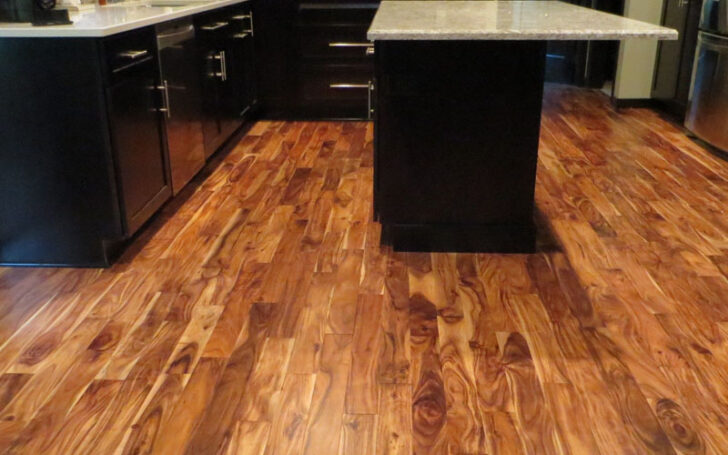
This dynamic wood option adds a lively and unique touch to the warmth inherent in hardwoods. Knots and veins are more prominent than regular hardwoods used for flooring.
If you type “Acacia wood flooring” in the search bar of your browser, you will encounter many sales platforms such as Homedepot, Floor and Decor, Lowes.
What does this suggest?
It is now normally used for flooring.
But why?
Firstly:
There’s a nice variation in the color and pattern of each floor slab you put in. From brown to red and gold, it will brighten your room’s floor.
Second:
It is one of the best hardwood floors, so it will be able to sustain (and not damage) foot traffic.
Third:
It provides natural resistance to water, so it won’t swell or anything. You can clean it with brooms and it is a great wood flooring option for damp areas. Acacia can live in such areas for years.
Fourth:
It is scratch resistant, so you can easily move your furniture on it. Some suppliers even offer a 50-year warranty on their acacia wood flooring.
You can get it in Solid, Engineered or Laminate form. Acacia aside, you need to take extra care of every hardwood floor. Use a high quality mop to clean. Mop slippers can also be used.
In addition, since it contains natural oils, it is resistant to pests and this problem is solved.
3. Outdoor and Patio Furniture
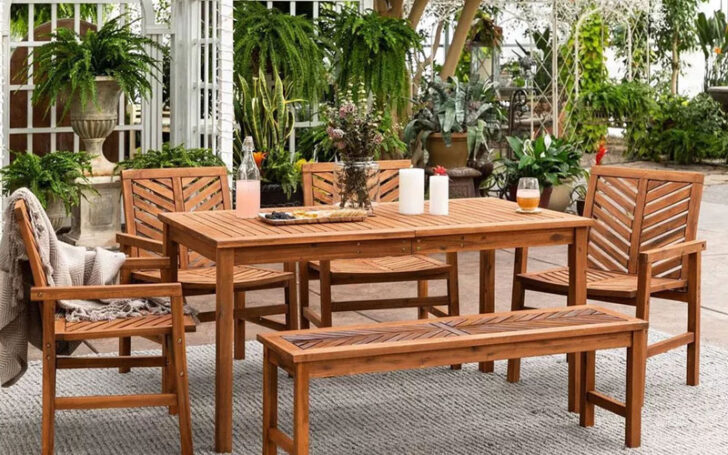
What are you looking for in a patio table set?
It should be light, weather resistant, strong and attractive.
Acacia wood checks all of the above except the first quality.
Contains natural oils that make it rot resistant. It is also water resistant as discussed above. Drink wine in glasses or drink juices without fear.
It’s durable and tough, so it can be easily hit by a drowning water hose or falling off the floor from children playing around it.
The wavy vein pattern and soft sheen greatly complement the beauty of the patio or outdoor lawn.
It is also much cheaper than teak, another wood commonly used in outdoor furniture.
Acacia Wood Bowls
Do something.
Search for the full title above in your browser and we bet you’ll be surprised how popular and sought-after these bowls are.
Amazon, Etsy, Target; All e-commerce giants have it.
People in the Philippines and Hawaii use it profusely.
That means it’s popular, and here are three reasons why.
Firstly:
It is resistant to water penetration and stains.
Second:
Since it does not smell, it can be used for a long time without being disgusted.
Third:
It looks elegant and classic.
Fourth:
It is a food-safe option for hot and cold ingredients.
Acacia wood products can create a wonderful contrast with other metallic, silicone and plastic kitchenware. Another great option for wooden utensils is olive wood.
Some of you may be wondering why we and the internet are raving about this tree species.
This is because it is superior to many other woods we normally use or know.
Acacia Wood Vs Other Wood Types:
1. Acacia vs Teak
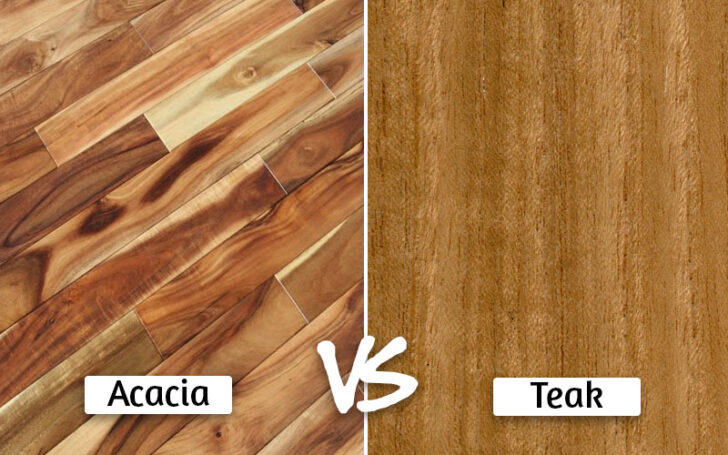
We won’t go into the roots of origins and traits to bore you. Instead, we would explain why this wood should be used instead of its competitors.
First of all, teak has more variations (colors and textures) than teak, so if you use Acacia instead of teak, your furniture will have more color options.
Second, it can be polished much more easily than teak.
Third, it’s less expensive than teak and offers almost the same durability, so there’s no financial burden with this wood either :p
2. Acacia vs Oak
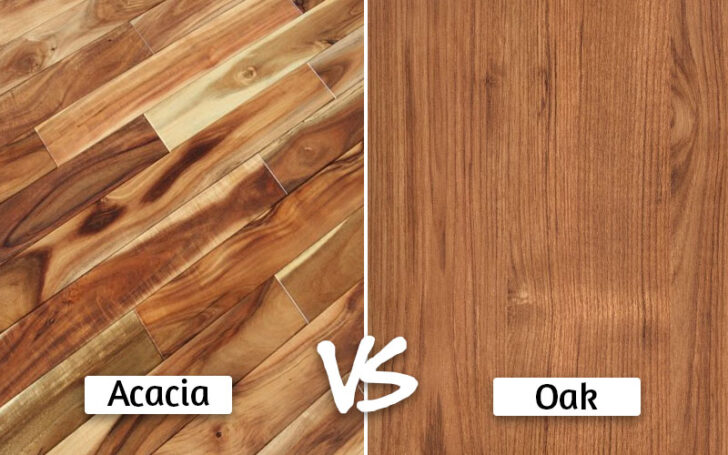
Oak is another wood commonly used for flooring, furniture, and cabinets, but Acacia can beat it too.
How?
Acacia is harder than oak, which provides greater effectiveness in the case of flooring. According to Carpet Express (JANKA Acacia Hardness Number 2200), it is 70% harder than Red Oak and 65% harder than White Oak.
Since they have a short lifespan of 15-30 years, they are more sustainable than oak trees, so they can grow quickly, while oak trees have an average lifespan of 80-200 years.
Also, unlike oak, the “great” Acacia wood is minimally likely to bend.
3. Acacia vs Walnut
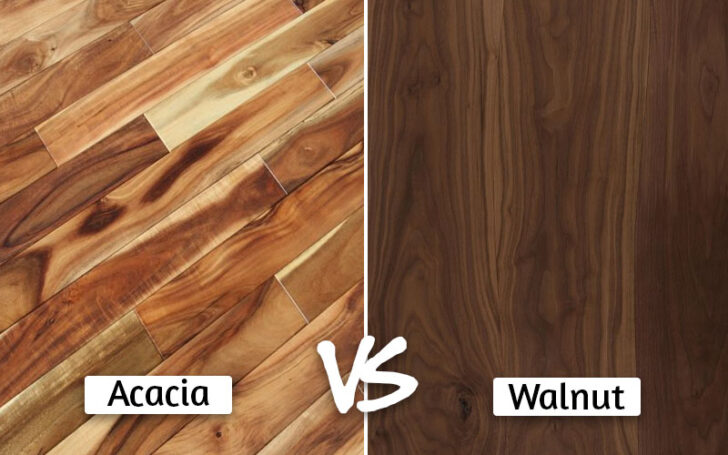
Akasya offers fierce competition to walnuts in flooring and cutting boards.
For cutting boards:
It is much cheaper than walnut, sustainable and provides natural water resistance. Also, because it is harder than walnut, knife and fork scratches are less likely.
For flooring:
In addition to better appearance and durability, it is cheaper than walnut flooring and gives a better shine when polished.
Are There Any Disadvantages Of Acacia Wood?
Nothing comes without disadvantages.
Here we have detailed the cons of acacia wood:
1. Irregular Color And Grain Texture Knots
Acacia Tree can show different colors and patterns on your floors or cabinets, which may not be liked by some people.
While many see the color and grain variations as a plus point of this wood, those who need a consistent color in their flooring and furniture may be uncomfortable with this.
2. Acacia Wood is Expensive
Acacia wood is more expensive than regular hardwoods like Maple and Oak.
3. It Doesn’t Have a Lot of Natural Oils as Teak
We have previously discussed that Acacia is a great wood option for outdoor furniture, but it needs oiling for long-term protection from weather and pests.
Teak can be left untreated for decades.
4. Cross-grain Scratches Are Nearly Impossible to Remove
You can fill in normal stains with a filler pen or paint, but cross-grain scratches are very difficult to deal with.
Why?
Because of the differences in color and veining: Even if you get the right color, daunting tasks are always added to match the markings.
5. Outdoor Acacia Furniture May Need More Maintenance Than Indoor:
Acacia wood is considered a temperature sensitive lumber and high maintenance when used outdoors for furniture, pavilions and Cabanas.
The main reason for this may be the lack of natural oils, but if you are prepared to properly care for acacia wood furniture, it will not be a problem.
6. Furniture May Darken With Time:
Furniture made of acacia wood can darken over time; however, if it is well-kept and polished, it can last for years.
Where & How To Buy it – Acacia Wood for Sale
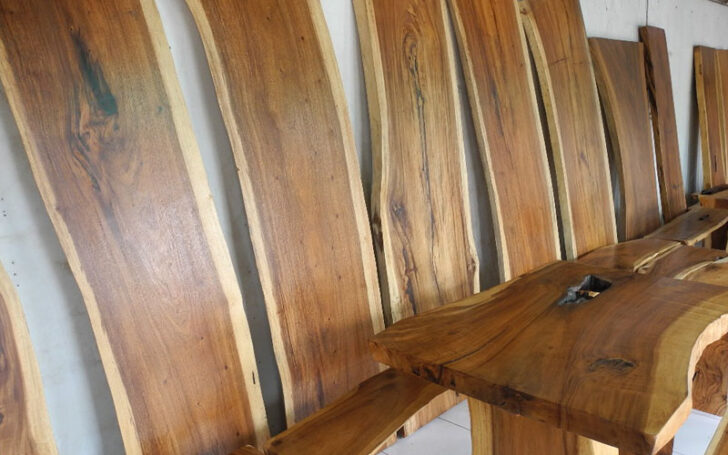
While there are many reliable e-commerce platforms that sell acacia wood planks and products, we recommend you local hardwood stores.
because
A: There is a difference in the color and shape shown in the product description and the actual
B: you cannot negotiate with an online store
If we talk about flooring depending on the general trend:
Engineered Acacia will cost around $2.6-8/m², Solid Hardwood will cost you $2.6-8/m², and the Laminated one will be available at $0.8-3.5 per square foot .
Acacia wood boards are normally in the $2 to $5 range, even if you want grays. The prices of their furniture depend on the brand and the finish.
Prices for bowls and cutting boards made of Acacia depend on the brand and coating and are the same as for the same furniture.
It is best to have a carpenter or carpenter with you when purchasing acacia planks and planks as they can better understand their reliability.
How To Extend Its Life – Acacia Wood Care
There is no doubt that it is a durable tree species. But proper care can extend its life for decades.
1. Furniture Care:
- To clean up spills, use a cloth dampened with warm soapy water instead of using cleaning fluids containing silicone or ammonia. It dries the wood.
- It is always recommended to use coasters when placing glasses or glasses on wood.
Use Beeswax furniture polish when you feel that the item has lost its shine. This is a necessary furniture care trick. Apply the wax according to the labeled directions.
2. Floor Care:
- For floor care; Do not allow liquids spilled on floors to dry. Clean it quickly.
- If you see gaps between floor slabs, call a specialist and make any necessary repairs instead of testing it yourself. Every Acacia board is different.
3. Outdoor Furniture Care:
If outdoor furniture is placed near a swimming pool, be sure to spray it thoroughly with the power washer hose. Chlorine from pool water depletes the weatherproof coating of Acacia wood furniture.
Do not expose to direct sunlight as it may cause cracking or discoloration. Moving patio furniture regularly is therefore recommended. Place it under a canopy or tree.
Concluding Words
The acacia tree is gaining popularity around the world for the reasons stated in the blog.
Before you leave, let us know your experiences with Acacia wood in the comment section.
Also, don’t forget to pin/bookmark and visit our blog for more interesting but original information. (Vodka And Grape Juice)

